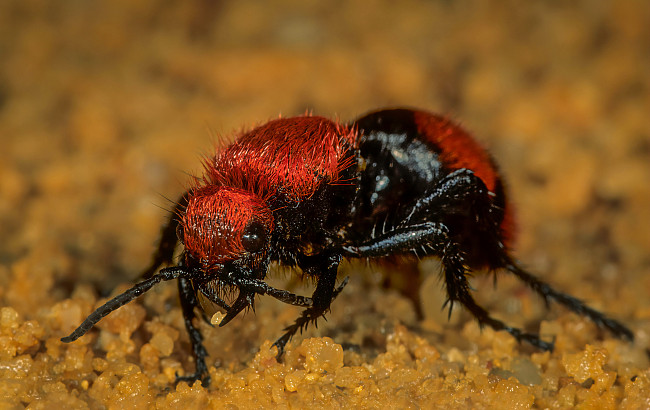Researchers have delved into the mysteries of one of nature’s most agonizing stings, uncovering how a seemingly beautiful insect utilizes its chemical weaponry with precise effectiveness. This breakthrough could pave the way for advancements in pain management treatments.
Despite its name, the scarlet velvet ant is actually a wasp whose sting is likened to “hot oil from the deep fryer spilling over your entire hand.” However, the intense pain caused by this sting comes with an interesting twist – the venom is not highly toxic, indicating that evolution has tailored it as a deterrent rather than a lethal weapon.
In a pioneering study published in Current Biology, scientists at Indiana University Bloomington have unveiled how this unique venom targets pain receptors in different species using distinct mechanisms, offering new insights for medical research.
“Our findings suggest that velvet ants are able to interact with the pain systems of various animals, such as mammals, birds, and other insects, through different mechanisms,” stated Lydia Borjon, Assistant Scientist at the Tracey Lab at IU’s Gill Institute for Neuroscience.
Through their research, the team made an unexpected discovery about the venom’s main component – a peptide called Do6a. Borjon pointed out, “Do6a not only strongly activates pain-sensing neurons in insects, but it is also the most abundant peptide in the venom. This indicates that defense against other insects played a crucial role in the evolution of the venom composition.”
By conducting tests on fruit flies, the scientists pinpointed specific nerve cells that respond to the venom even at highly diluted levels. These pain-sensing neurons, known as nociceptors, share similarities with pain receptors found in humans and other mammals, albeit reacting to different elements of the venom.
“This study underscores the remarkable precision of evolutionary adaptations,” noted Dan Tracey, Professor in the College’s Biology department and Linda and Jack Gill Chair of Neuroscience. “Velvet ants have honed their venom to target specific molecular receptors in a way that enhances their survival advantage.”
To demonstrate the venom’s efficacy as a deterrent, researchers evaluated its impact on praying mantises, observing clear avoidance behaviors that confirmed its defensive power in the insect world.
“Investigating how velvet ant venom affects different species provides valuable insights into pain pathways, with potential implications for advancing medical research,” commented Luana de Assis Ferreira, a postdoctoral researcher involved in the study.
Beyond understanding these intriguing creatures, the implications extend to pharmacology and medicine. Andrea Hohmann, Professor in the College’s Psychological and Brain Sciences department, added, “Venoms contain valuable bioactive compounds, and studying them often leads to breakthroughs in medicine and pharmacology.”
The research team utilized advanced imaging techniques and genetic experiments to unravel how nerve cells respond to the venom, identifying specific ion channels as essential for its effects. When these channels were eliminated or deactivated in fruit flies, the nerve cells no longer reacted to the venom.
As research progresses, these findings could potentially pave the way for novel approaches in developing pain medications. Tracey concluded, “With these discoveries, we are closer to understanding, and possibly harnessing, the power of velvet ant venom.”
If you found this information helpful, please consider supporting our work with a small, one-time, or monthly donation. Your contribution enables us to continue providing you with reliable, thought-provoking updates on science and medicine. Independent reporting requires time, dedication, and resources, and your support allows us to delve into stories that are important to you. Together, we can ensure that significant discoveries and progress reach those who need them most.






